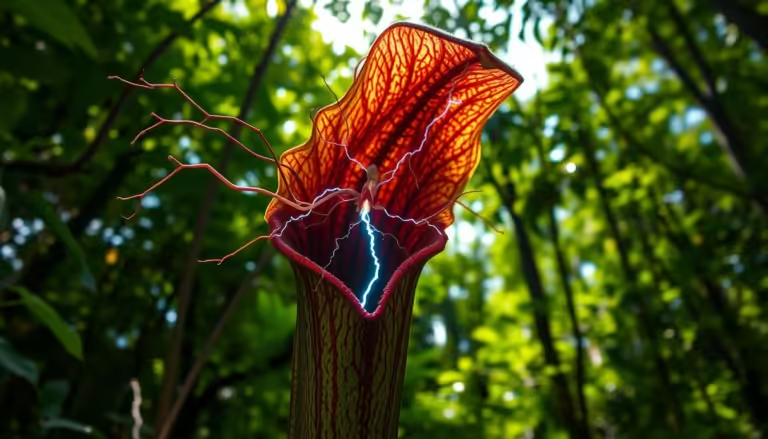A groundbreaking discovery in the Himalayas has unveiled a unique lichen that exhibits a remarkable trait: it flashes UV light when wet, attracting mites to facilitate the dispersal of its spores.

This extraordinary lichen, unlike typical lichens, glows dynamically, opening new avenues for research in microbiology and biotechnology. The discovery, observed in 2024, has significant implications for understanding the complex interactions between organisms in unique ecosystems.
The finding highlights the intricate relationships within the natural world and underscores the importance of continued exploration and research into the natural world.
Key Takeaways
- The Himalayan lichen exhibits a unique trait of flashing UV light when wet.
- This phenomenon attracts mites, aiding in the dispersal of the lichen’s spores.
- The discovery has significant implications for microbiology and biotechnology.
- The observation was made in 2024, marking a recent breakthrough.
- The lichen’s dynamic glow distinguishes it from typical lichens.
- The finding underscores the complexity and richness of natural ecosystems.
The Glowing Discovery in the Himalayan Heights
Researchers have identified a lichen in the Himalayan region that exhibits UV illumination when wet, a phenomenon observed in 2024. This discovery has sparked significant interest in the scientific community due to its unique characteristics and potential implications for microbiology.
First Observations of the Phenomenon
The initial observation of the lichen’s UV illumination was made by a team of researchers studying the diverse flora of the Himalayas. They noted that when the lichen came into contact with water, it emitted a UV glow, which was not previously documented in any lichen species.
The 2024 Scientific Documentation
The scientific documentation of this phenomenon in 2024 provided detailed insights into the lichen’s behavior and its interaction with mites. The study revealed that the UV light aids in the reproduction of the lichen by attracting mites that help disperse its spores.
| Year | Observation | Significance |
|---|---|---|
| 2024 | UV illumination in wet conditions | Aids in lichen reproduction |
| Previous Years | No UV illumination observed | Limited understanding of lichen behavior |

Scientists are now studying this phenomenon to understand its implications for microbiology and potential applications in various fields.
Understanding Lichens: Nature’s Composite Organisms
At the heart of lichens lies a symbiotic relationship that has captivated scientists for centuries. Lichens are not single organisms but a partnership between fungi and algae or cyanobacteria. This unique relationship allows lichens to thrive in diverse environments, from the freezing tundra to the hottest deserts.
The Symbiotic Relationship Between Fungi and Algae
The fungal component of lichens, known as the mycobiont, provides the structural framework, while the algal or cyanobacterial component, known as the photobiont, is responsible for photosynthesis. This partnership is mutualistic, with the fungi offering protection and nutrients to the algae, which in turn produce nutrients through photosynthesis.
| Component | Role |
|---|---|
| Fungi (Mycobiont) | Provides structure, protection, and nutrients |
| Algae/Cyanobacteria (Photobiont) | Produces nutrients through photosynthesis |
How Lichens Typically Reproduce
Lichens reproduce through various methods, including the production of spores and vegetative propagation. Some lichens produce specialized structures called soredia, which contain both fungal and algal cells, allowing for the dispersal of the entire organism. The Himalayan lichen in question has a unique method of reproduction involving mites to spread its spores.

The interaction between lichens and mites is an example of a complex ecological relationship, where mites are lured by the lichen’s UV light when wet, facilitating the dispersal of its spores. This lichen mating strategy highlights the intricate adaptations that have evolved in these composite organisms.
In the Himalayas, a Lichen Flashes UV When Wet, Luring Mites to Spread Spores
Researchers have identified a remarkable lichen in the Himalayas that displays a dynamic UV glow in response to water, facilitating its reproduction. This phenomenon is not only intriguing but also sheds light on the complex interactions between lichens and their environment.
The Mechanism Behind the UV Illumination
The UV illumination in this Himalayan lichen is triggered by a complex biochemical process. When the lichen comes into contact with water, a series of molecular interactions occurs, leading to the emission of UV light. This process is facilitated by a symbiotic relationship between the fungal and algal components of the lichen, which work together to produce the necessary biochemicals for bioluminescence.
The key steps involved in this mechanism include:
- The absorption of water, which triggers a biochemical cascade.
- The production of a specific molecule that reacts to form a UV-emitting compound.
- The emission of UV light, which is believed to be an adaptive trait to attract mites for spore dispersal.

How Water Triggers the Bioluminescent Response
Water plays a crucial role in triggering the bioluminescent response in this lichen. The presence of water initiates a series of biochemical reactions that ultimately lead to the production of UV light. This response is thought to be an adaptation to the lichen’s environment, where water availability is intermittent.
The bioluminescent response is characterized by a rapid increase in UV emission upon wetting, followed by a gradual decrease as the lichen dries out. This dynamic response is unlike typical lichens, which do not exhibit such a pronounced reaction to moisture, highlighting the unique characteristics of this Himalayan species.
The Role of Mites in Lichen Reproduction
Mites play a crucial role in the reproductive cycle of the Himalayan lichen that flashes UV light when wet. This unique lichen has evolved a complex strategy to ensure its spores are dispersed effectively, and mites are key players in this process.

Mite Species Involved in Spore Dispersal
Research has identified specific mite species that are attracted to the UV signal emitted by the lichen. These mites are not just random visitors; they are integral to the lichen’s reproductive strategy. As they move from one lichen colony to another, they carry spores with them, facilitating the spread of the lichen.
- The oribatid mite species has been observed to be particularly effective in spore dispersal.
- These mites are drawn to the UV light, which serves as a signal for them to visit the lichen.
The Mutualistic Relationship Between Lichens and Mites
The interaction between the Himalayan lichen and the mites is a mutualistic one, meaning both parties benefit. The lichen gains by having its spores dispersed, while the mites receive a signal that guides them to a potentially nutrient-rich environment. This relationship highlights the intricate connections within ecosystems, even in the harsh conditions of the Himalayan heights.
Unlike Typical Lichens: What Makes This Species Unique
The Himalayan lichen exhibits a unique characteristic that sets it apart from other lichens. While most lichens display static bioluminescence, this species glows dynamically when wet, emitting UV light to attract mites for spore dispersal.

Comparing Static vs. Dynamic Bioluminescence in Lichens
Static bioluminescence is a common feature among many lichen species, where they emit a constant glow. In contrast, the Himalayan lichen’s dynamic bioluminescence is triggered by water, making it a more adaptive and responsive trait. This dynamic response allows the lichen to conserve energy when it’s dry and activate its signaling when moisture is present.
Evolutionary Advantages of UV Signaling
The UV signaling mechanism employed by the Himalayan lichen offers several evolutionary advantages. By attracting mites to facilitate spore dispersal, the lichen enhances its reproductive success. This lichen teamwork with mites exemplifies a mutualistic relationship where both organisms benefit. The potential for this discovery to inspire new spore-dispersal tech is significant, as it could lead to innovative methods in agriculture and conservation.
Unlike typical lichens, this species glows dynamically, showcasing an extraordinary example of adaptation to its environment. The unique characteristics of this lichen not only highlight the diversity of biological strategies in extreme environments but also underscore the potential for scientific innovation inspired by nature.
The Harsh Himalayan Environment and Lichen Adaptation
In the harsh conditions of the Himalayas, lichens have developed remarkable adaptations to survive and thrive. The Himalayan environment is characterized by extreme altitudes, intense sunlight, and variable temperatures, making it one of the most challenging habitats for organisms.
Surviving Extreme Altitude Conditions
Lichens in the Himalayas have adapted to survive at extreme altitudes where oxygen levels are low, and UV radiation is intense. These organisms have developed specialized physiological mechanisms to withstand such conditions. For instance, they can regulate their metabolic activities according to the availability of water, allowing them to survive desiccation.
Seasonal Patterns of UV Activity
The UV activity in Himalayan lichens exhibits seasonal patterns that are closely linked to their reproductive strategy. During the wet season, the lichens emit UV light to attract mites for spore dispersal. This synchronized activity ensures the effective spread of spores, enhancing the lichen’s reproductive success. The table below summarizes the seasonal UV activity patterns observed in these lichens.
| Season | UV Activity Level | Reproductive Activity |
|---|---|---|
| Wet Season | High | Active spore dispersal |
| Dry Season | Low | Dormant |
The seasonal variation in UV activity highlights the lichen’s adaptive strategy to optimize its reproductive success in the challenging Himalayan environment.

The Science of Bioluminescence in Alpine Environments
The science behind bioluminescence in alpine environments reveals intriguing insights into the adaptations of certain organisms. Bioluminescence, the production and emission of light by living organisms, is a complex process that involves a series of chemical reactions.
How UV Light Functions at High Altitudes
At high altitudes, such as those found in the Himalayas, the atmosphere is thinner, and UV radiation is more intense. This environment poses unique challenges and opportunities for organisms adapted to these conditions. The lichen species in question has adapted to utilize UV light as part of its reproductive strategy.
| Altitude | UV Intensity | Lichen Response |
|---|---|---|
| Low | Moderate | No UV emission |
| High | High | UV emission when wet |
The Chemistry Behind the Glow
The bioluminescent glow of the Himalayan lichen is the result of a chemical reaction involving a luciferin-luciferase reaction, similar to that found in fireflies. When the lichen is wet, the reaction is triggered, leading to the emission of UV light.
“The discovery of this lichen’s bioluminescent properties opens new avenues for understanding the complex interactions between organisms in alpine ecosystems.”
The study of bioluminescence in alpine environments not only deepens our understanding of these unique ecosystems but also has potential applications in biotechnology and beyond.
Ecological Significance of the Himalayan Glowing Lichen
Ecologists have been intrigued by the glowing lichen found in the Himalayas, which has been found to play a vital role in the alpine ecosystem. This unique organism contributes to the richness and complexity of the ecosystem in various ways.
Impact on Local Biodiversity
The Himalayan glowing lichen has a significant impact on local biodiversity. By attracting specific mite species that aid in spore dispersal, it ensures its own propagation and potentially influences the population dynamics of these mites. This interaction can have cascading effects on the local food web and ecosystem balance.
As noted by a recent study, “The mutualistic relationship between the glowing lichen and mites exemplifies the intricate connections within alpine ecosystems” (
This relationship highlights the complex interdependencies in nature.
).
Role in the Alpine Ecosystem
The glowing lichen plays a crucial role in the alpine ecosystem by contributing to the overall biodiversity and ecological stability. Its ability to thrive in harsh, high-altitude conditions makes it a key component of the ecosystem, providing a habitat and resources for other organisms.
The ecological significance of the Himalayan glowing lichen is multifaceted, involving both its direct interactions with other organisms and its contribution to the overall resilience of the alpine ecosystem.
Research Methodologies: Studying Microscopic Interactions
To unravel the mysteries of the glowing lichen, researchers employed a range of techniques to study its interactions with mites. The study of these microscopic interactions required a combination of field observations and laboratory analyses.
Field Observation Techniques in Remote Himalayan Regions
Field observations were conducted in the remote Himalayan regions where the lichen was found. Researchers used specialized equipment to observe and record the interactions between the lichen and mites in their natural habitat. These observations provided valuable insights into the behavior of both the lichen and the mites.
Laboratory Analysis of the UV Properties
In the laboratory, researchers analyzed the UV properties of the lichen to understand the mechanism behind its bioluminescence. Advanced spectroscopy techniques were used to study the emission spectra of the lichen, providing insights into the chemical processes involved in its glow.
The laboratory analyses complemented the field observations, offering a comprehensive understanding of the lichen-mite interaction. By combining these methodologies, researchers were able to elucidate the complex relationships between the lichen and its environment.
Potential Applications in Biotechnology and Biomimicry
With its extraordinary ability to lure mites for spore dispersal, the Himalayan lichen is a fascinating subject for biotechnological innovation. The unique characteristics of this lichen could inspire new approaches in various fields, from environmental science to industrial applications.
Inspiration for Spore-Dispersal Technologies
The mechanism by which the Himalayan lichen uses UV light to attract mites could inspire spore-dispersal tech for various applications. This might include more efficient methods for dispersing beneficial microorganisms in agriculture or developing targeted delivery systems for microorganisms in environmental remediation projects.
| Potential Application | Description | Benefit |
|---|---|---|
| Agricultural Microorganism Dispersal | Using UV signaling to disperse beneficial microbes | Increased crop yield and health |
| Environmental Remediation | Targeted delivery of microorganisms for pollution cleanup | Efficient removal of contaminants |
Bioluminescent Applications in Science and Industry
The bioluminescent properties of the Himalayan lichen have far-reaching implications for bioluminescent applications in science and industry. This includes the development of novel lighting solutions, biosensors, and diagnostic tools that leverage bioluminescence for various purposes.
The lichen teamwork between fungi and algae not only fascinates scientists but also opens up new avenues for research and development. By understanding and mimicking such natural symbioses, scientists can innovate and create new technologies that are both efficient and environmentally friendly.
Conservation Implications for Rare Alpine Lichens
The unique biological mechanisms of the Himalayan lichen highlight the need for targeted conservation strategies. This newly discovered species, with its ability to emit UV light, is not only a fascinating scientific find but also a crucial component of the alpine ecosystem.
Threats to Himalayan Lichen Populations
Himalayan lichen populations are facing numerous threats, including climate change, habitat destruction, and pollution. Rising temperatures are altering the delicate balance of the alpine environment, making it challenging for these sensitive organisms to survive. A detailed analysis of these threats is crucial for developing effective conservation plans.
| Threat | Impact on Lichens | Conservation Measure |
|---|---|---|
| Climate Change | Alters environmental balance | Monitor temperature changes |
| Habitat Destruction | Reduces lichen habitats | Protect alpine areas |
| Pollution | Damages lichen health | Reduce pollution levels |
Preservation Efforts for Unique Biological Mechanisms
To preserve the unique biological mechanisms of the Himalayan lichen, conservationists are implementing various preservation efforts. These include protecting their habitats, studying their reproductive cycles, and raising awareness about the importance of these organisms.
By understanding and protecting these rare alpine lichens, we can maintain the biodiversity of the Himalayan region and ensure the long-term health of this unique ecosystem.
Conclusion: Nature’s Glowing Couriers of the Himalayas
This discovery reveals a glowing courier that is redefining our understanding of lichen reproduction in the Himalayas. In the Himalayas, a lichen flashes UV when wet, luring mites to spread spores, showcasing a unique symbiotic relationship.
Offering insights into how lichens travel alpine slopes, this phenomenon highlights the intricate mechanisms that allow these organisms to thrive in extreme environments. The UV illumination triggered by water not only aids in spore dispersal but also underscores the complex interactions between lichens and mites.
As research continues to unravel the secrets of this glowing lichen, its discovery opens up new avenues for understanding ecological balance and biodiversity in alpine ecosystems. By exploring the potential applications of this phenomenon in biotechnology and biomimicry, scientists can gain valuable insights into innovative spore-dispersal technologies and bioluminescent applications.


